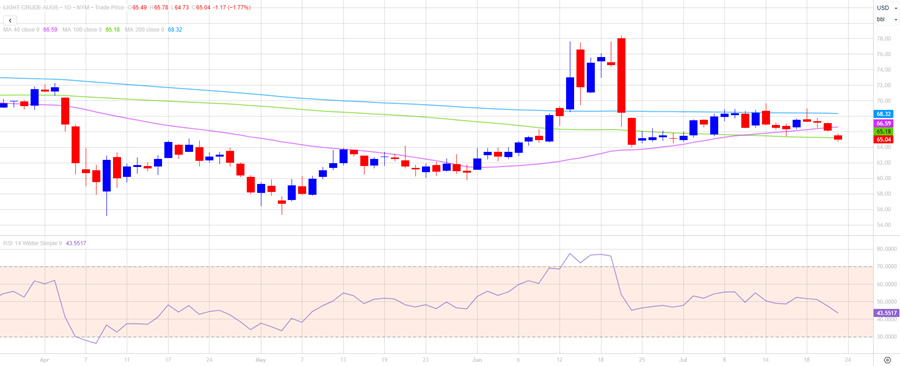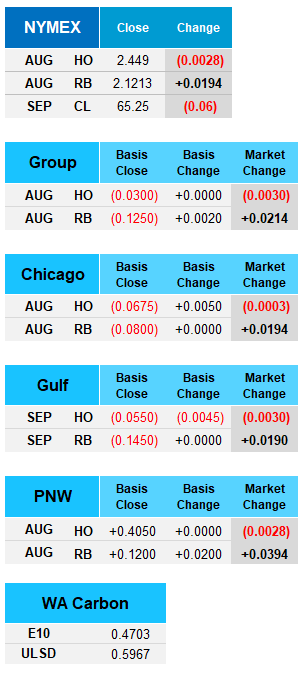Russia Sanctions: Earlier this month, President Donald Trump suggested that the U.S. could implement 100% tariffs on purchasers of Russian oil and introduce additional sanctions if Russia fails to reach a significant peace agreement with Ukraine by early September. "This puts immense pressure on Russia," U.S. Energy Secretary Chris Wright said during an interview on Fox News' Special Report with Bret Baier. "It’s the most powerful leverage we have." Wright emphasized that the U.S., as the world’s leading oil and gas producer, now has the capacity to take actions that were previously considered unattainable. "We’re in a position to do things we couldn’t before," he added. Despite this strategic advantage, the Trump administration has so far refrained from imposing major oil sanctions on Russia, opting instead to target Iran, an OPEC member, since Trump began his second term in January.
Saudi Arabia Imports: In June, Saudi Arabia emerged as the leading destination for Russian seaborne fuel oil exports, driven by increased energy demand during the hot summer months, according to traders and LSEG (London Stock Exchange Group) data. This shift follows the European Union’s full embargo on Russian oil products, which took effect in February 2023, prompting Russia to redirect its fuel exports primarily to Middle Eastern and Asian markets. Direct shipments from Russian ports to Saudi Arabia rose by 9% month-over-month, reaching 0.8 million metric tons.
U.S. Inventories: According to the American Petroleum Institute report yesterday, the change U.S. inventories were mixed and inconsistent with early expectations from a Reuters poll. Crude is expected to see a draw of nearly 600 thousand barrels, gasoline expected to draw 1.2 million barrels while diesel showing a build of 3.5 million barrels. We will wait to see what the Department of Energy posts this afternoon for actual figures.
Market Overview: Oil prices are on the decline for the fourth straight session this morning as investors weighed trade developments and awaited U.S. inventory data. The market was pressured by news of a U.S.-Japan trade deal involving a 15% tariff and ongoing tensions with the EU and China, which continue to dampen sentiment. The EU is preparing counter-tariffs on $109 billion worth of U.S. goods but still hopes for a negotiated resolution. Meanwhile, the U.S. is considering sanctions on Russian oil, and the EU has introduced its 18th sanctions package, lowering the price cap on Russian crude.

The WTI crude oil chart shows a recent downward trend, with the latest trade price at $65.04. The candlestick pattern indicates consistent selling pressure over the past few sessions. The price is currently below the 40-day (purple), 100-day (green), and 200-day (blue) moving averages, making all three levels of resistance at this time. The Relative Strength Index (RSI) is at 43.56, suggesting that the market is approaching oversold territory but not yet at extreme levels. Overall, the chart also shows a relatively back and forth trend for WTI for the past few weeks trading mostly between a channel of $68-$64 a barrel.

Oil prices remained mostly steady on Wednesday as investors evaluated trade developments between the U.S. and the EU following a new U.S.-Japan tariff deal. The EU is moving toward a trade agreement with the U.S. that would impose a 15% tariff on EU goods, avoiding a harsher 30% tariff set for August 1. Meanwhile, the U.S.-Japan deal includes reduced auto tariffs and a $550 billion investment package. Despite this progress, concerns persist over unresolved trade talks with the EU and China, which continue to weigh on market sentiment. On the supply side, U.S. crude inventories fell by 3.2 million barrels last week, a larger-than-expected draw driven by higher exports and lower imports. Additionally, the U.S. is considering sanctions on Russian oil, while the EU has introduced its 18th sanctions package, further lowering the price cap on Russian crude.

